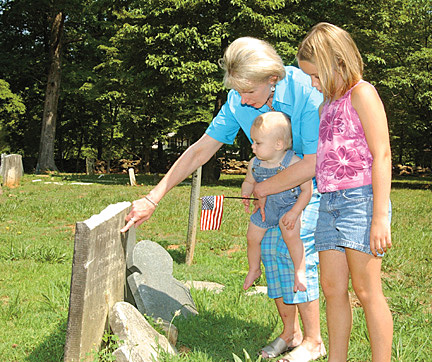|
Family relives history at gravesite
|
 |
| (Published July 3, 2002. Reprinted with permission of The Fort Mill Times.)
By Mac Banks It's important that her family know about their ancestor, Bortner says, especially during these times when the American way of life is threatened. "You don't know where you are going unless you know where you are," she says. Bortner is working on replacing Faires' headstone in the old cemetery. She has tried to piece parts of Faires' life together and how he came to be buried in Fort Mill. The history is sketchy, but one thing is for sure, it was Faires' courage that led him to run off and join the fight for freedom. "If it wasn't for men like Alexander, we wouldn't have this country," Bortner says. "These plain old farmers, they are the ones that did it." Faires was born 1740 in Ireland. He came to America in 1740 and settled in Delaware. He married Jenet Hall of Delaware and the two, along with the first two of their eight children, moved to South Carolina in 1776 and settled in the York District, now known as York County. Faires then entered the revolution, joining Gen. Thomas Sumter's army. According to Bortner's family history, Faires fought in two major battles in the fight for independence. He fought with Sumter in the Battle of Hanging Rock and the Battle of Fishing Creek. At Fishing Creek, Faires killed one of Gen. Charles Cornwallis' soldiers, but he was severely wounded when he was cut across the face with a saber. He was captured and taken to a British prison in Camden, where he quickly escaped. He hid in the India Hook Hills for several days until his wife was able to nurse him back to health. Once healthy, he rejoined Sumter's army at Charlotte. During the war, Faires and his wife had three more children, then three more following the war. Their sixth child, Jesse, who is also buried in Old Unity Cemetery, was born in 1787 and is the direct descendent (sic) of Bortner. He is her fourth great-grandfather. Throughout the remainder of his life, Faires leased huge areas of land. In 1813, Faires secured a lease from the Catawba Indians for 744 acres for $10 for 99 years. When he died in 1824 most of his land went to Jesse, then a school teacher, according to Bortner's family history. Sometime during his life, Jesse build a cabin on that land. It is believed that the cabin on the Anne Springs Close Greenway overlooking the Nation Ford Trail is the one built by Jesse. Jesse Faires died in 1845. Now, Bortner is raising money among her family members to install a new headstone for Faires — to honor his heroism and patriotism — and do her part to help clean up the historic, but crumbling, cemetery. "I don't care if I have a headstone, but Alexander is going to have one," Bortner says. "I want my grandson to be able to bring his grandchildren to see this." |